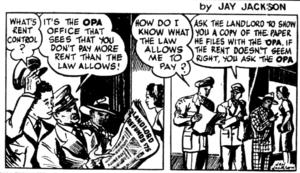Jay Jackson (artist) facts for kids
Quick facts for kids Jay Jackson |
|
|---|---|
| Born | September 10, 1905 Oberlin, Ohio, U.S. |
| Died | May 16, 1954 (aged 48) Los Angeles |
| Nationality | American |
|
Notable works
|
Editorial cartoons for The Chicago Defender Illustrations for Amazing Stories and Fantastic Adventures |
| Awards | American Newspaper Guild Front Page award (x2) |
| Spouse(s) | Eleanor Poston |
Jay Paul Jackson (born September 10, 1905 – died 1954) was an African-American artist. He worked for many years at The Chicago Defender, a well-known newspaper. He also drew pictures for science fiction magazines like Amazing Stories and Fantastic Adventures.
Early Life and Career
Jay Jackson was born in Oberlin, Ohio. He left school when he was thirteen years old. After that, he worked different jobs. He helped build railroads and worked in a steel mill.
He went to Ohio Wesleyan University for one year. He even tried being a boxer for a short time. Later, he started his own business painting signs. He then became a main artist for the Pittsburgh Courier newspaper.
In the mid-1920s, Jackson began selling his drawings to The Chicago Defender. He also sold art to Abbott’s Monthly. By 1933, he officially joined the staff at the Defender.
Working for the Defender
By 1934, Jay Jackson was in charge of all the cartoons for the Defender. He drew many different types of cartoons. These included editorial cartoons, which shared opinions on news. He also created many single-panel cartoons and comic strips.
Some of his comic strips for the Defender and other Black newspapers were:
- The Adventures of Bill
- As Others See Us
- Billy Ken
- Exposition Follies
- Senda
- Skin Deep
- Society Sue
- Speed Jackson
- Tisha Mingo
In 1934, he brought back and changed the Defender's old comic strip, Bungleton Green. A comics expert named Tim Jackson said that Jay Jackson drew an amazing amount of comics and pictures in the 1940s. His art really stood out in the newspapers. Jay Jackson married Eleanor Poston, who also worked at the Defender.
Jackson won two "Front Page" awards from the American Newspaper Guild. He was known for his sharp and funny drawings that made fun of racism and unfair political attacks.
Science Fiction Art
In 1938, a science fiction magazine called Amazing Stories was having problems. It was bought by William B. Ziff, a cartoonist who became an advertising man. Ziff put Ray Palmer, a science fiction fan, in charge of the magazine.
Ziff knew Jackson's work from the Defender. Jackson drew pictures for three stories in the first issue of Amazing Stories that Palmer edited (June 1938). For the next four years, Jackson's art appeared in almost forty issues of Amazing Stories. He also drew for its sister magazine, Fantastic Adventures. Often, he would illustrate more than one story in a single issue.
Jay Jackson is thought to be the first Black artist to regularly draw for science fiction magazines. At first, he wasn't very familiar with science fiction. But he learned more and became very good at drawing the funny science fiction stories that Palmer liked. Amazing Stories even featured him in their "Introducing the Author" section. This was rare for an artist. The magazine showed his photo, so readers knew he was Black. They also learned he was a college graduate with a family and lots of experience.
After four years, Jackson realized that science fiction could be a safe way to criticize problems in America. He saw that by setting stories on other planets or in the future, he could talk about real-world issues. He stopped working for the science fiction magazines. Instead, he turned the Defender's Bungleton Green strip into a science fiction story. Bungleton Green became a superhero.
In the new story, Bung is killed, then brought back to life and rebuilt. He travels through time. First, he goes to 1778 to show the sad history of American slavery. Then, he travels to Memphis in 2043. In this future, Black and white people live in a perfect world where race doesn't matter. But then, a new continent of green people appears. They treat white people ("chalkies") in a way that was sadly familiar to Jackson's Black readers in the 1940s.
Later Years and Legacy
In 1949, Jackson moved from Chicago to Los Angeles. He opened his art studio there. He stayed in Los Angeles for the rest of his life, except for a short time when he painted murals in Mexico.
Jackson worked on many different projects. He created a two-page art piece for Who’s Who in Colored America. He also drew pictures for Who’s Who in the United Nations. He worked for one of the Telecomics companies. These were early TV shows that showed comic strips on screen. A narrator and voice actors would talk over still pictures, with only a little bit of movement.
He also designed glamour girl postcards for a company called Colourpicture of Boston. He created two new comic strips he hoped to sell to newspapers. These were Girligags, which had pretty girls and jokes, and Home Folks. Home Folks was a more realistic and funny series about everyday African-American life. But neither of these strips found a publisher.
Jay Jackson died from a heart attack on May 16, 1954. His wife made sure the Defender published his two unsold comic strips. She also sold them to other major Black newspapers. These included the Michigan Chronicle, Louisville Defender, Tri-State Defender, and the New York Age Defender.


